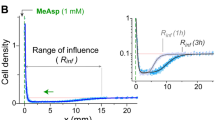Abstract
The chemotactic properties of spores of Actinoplanes brasiliensis were examined. The spores are attracted to chloride and bromide solutions but not to a number of organic compounds that are capable of supporting growth in chemically defined media. Chloride attraction has been tested in several other species of the genus and in a number of Actinoplanes strains isolated from soils. Some are attracted to chloride, but most strains are indifferent to the halide. In dense suspensions, the spores of A. brasiliensis show an apparent microaerophilic behavior. The ecological implications of the chemotactic properties of the A. brasiliensis spores are discussed.
Similar content being viewed by others
References
Adler, J.: Chemotaxis in bacteria. Science 153, 708–716 (1966)
Adler, J.: Chemoreceptors in bacteria. Science 166, 1588–1597 (1969)
Caraway, B. H., Krieg, N. R.: Aerotaxis in Spirillum volutans. Canad. J. Microbiol. 20, 1367–1377 (1974)
Couch, J. N.: The genus Actinoplanes and its relatives. Trans. N. Y. Acad. Sci. 16, 315–318 (1954)
Higgins, M. L.: Release of sporangiospores by a strain of Actinoplanes. J. Bact. 94, 495–498 (1967)
Lechevalier, M. P., Lechevalier, H. A.: Actinoplanete with cylindrical sporangia, Actinoplanes rectilineatus sp. nov. Int. J. syst. Bacteriol. 25, 371–376 (1975)
Palleroni, N. J., Doudoroff, M.: Some properties and subdivisions of the genus Pseudomonas. Ann. Rev. Phytopath. 10, 73–100 (1972)
Reichelt, J. L., Baumann, P.: Effect of sodium chloride on growth of heterotrophic marine bacteria. Arch. Microbiol. 97, 329–345 (1974)
Thiemann, J. E., Beretta, G., Coronelli, C., Pagani, H.: Antibiotic production by new form-genera of the Actinomycetales. II. Antibiotic A/672 isolated from a new species of Actinoplanes: Actinoplanes brasiliensis nov. sp. J. Antibiot. (Tokyo) 22, 119–125 (1969)
Waksman, S. A.: The actinomycetes, Vol. II, p. 330. Baltimore: Williams and Wilkins 1961
Willoughby, L. G.: Aquatic Actinomycetales with particular reference to the Actinoplanaceae. Veröff. Inst. Meeresforsch. Bremerhaven 3, 19–26 (1968)
Willoughby, L. G.: A study on aquatic actinomycetes. The allochthonous leaf component. Nova Hedwigia 18, 45–113 (1969)
Author information
Authors and Affiliations
Additional information
Dedicated to Professor R. Y. Stanier on the occasion of his 60th birthday
Rights and permissions
About this article
Cite this article
Palleroni, N.J. Chemotaxis in Actinoplanes . Arch. Microbiol. 110, 13–18 (1976). https://doi.org/10.1007/BF00416963
Received:
Issue Date:
DOI: https://doi.org/10.1007/BF00416963




